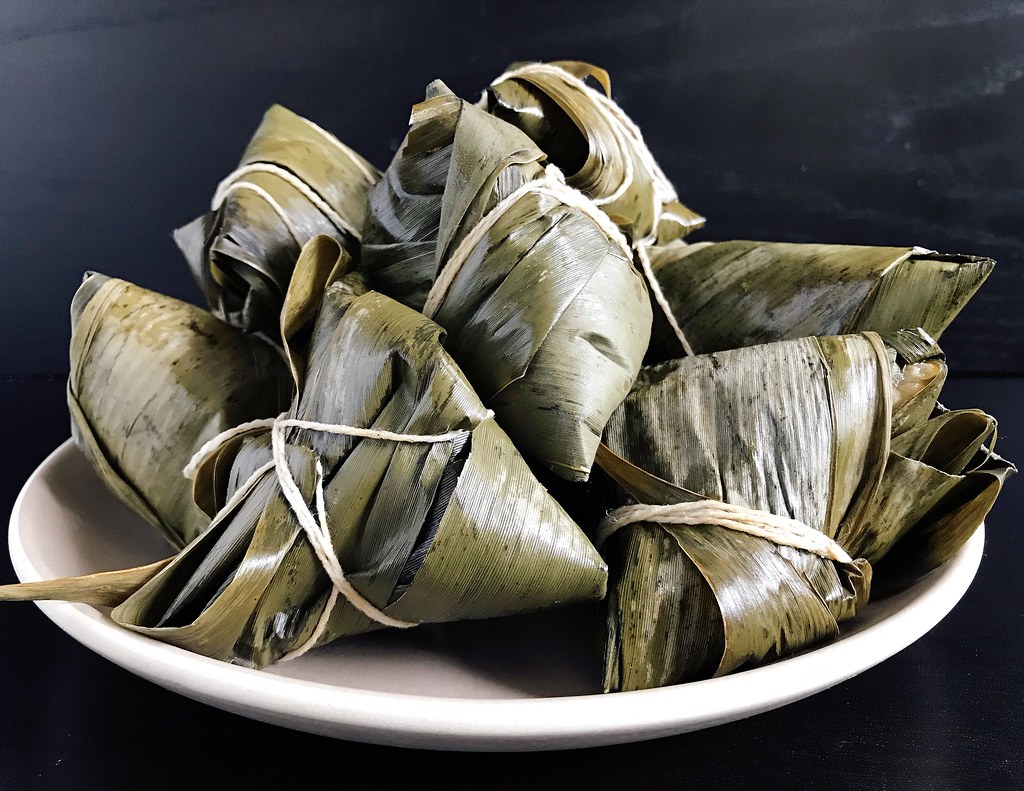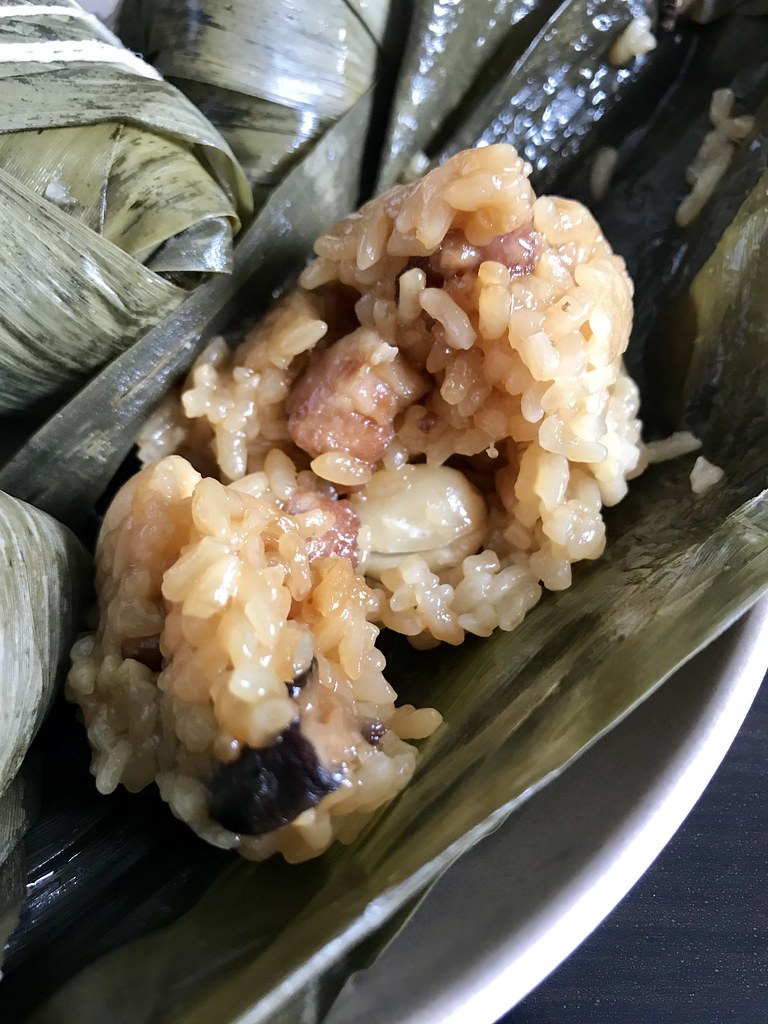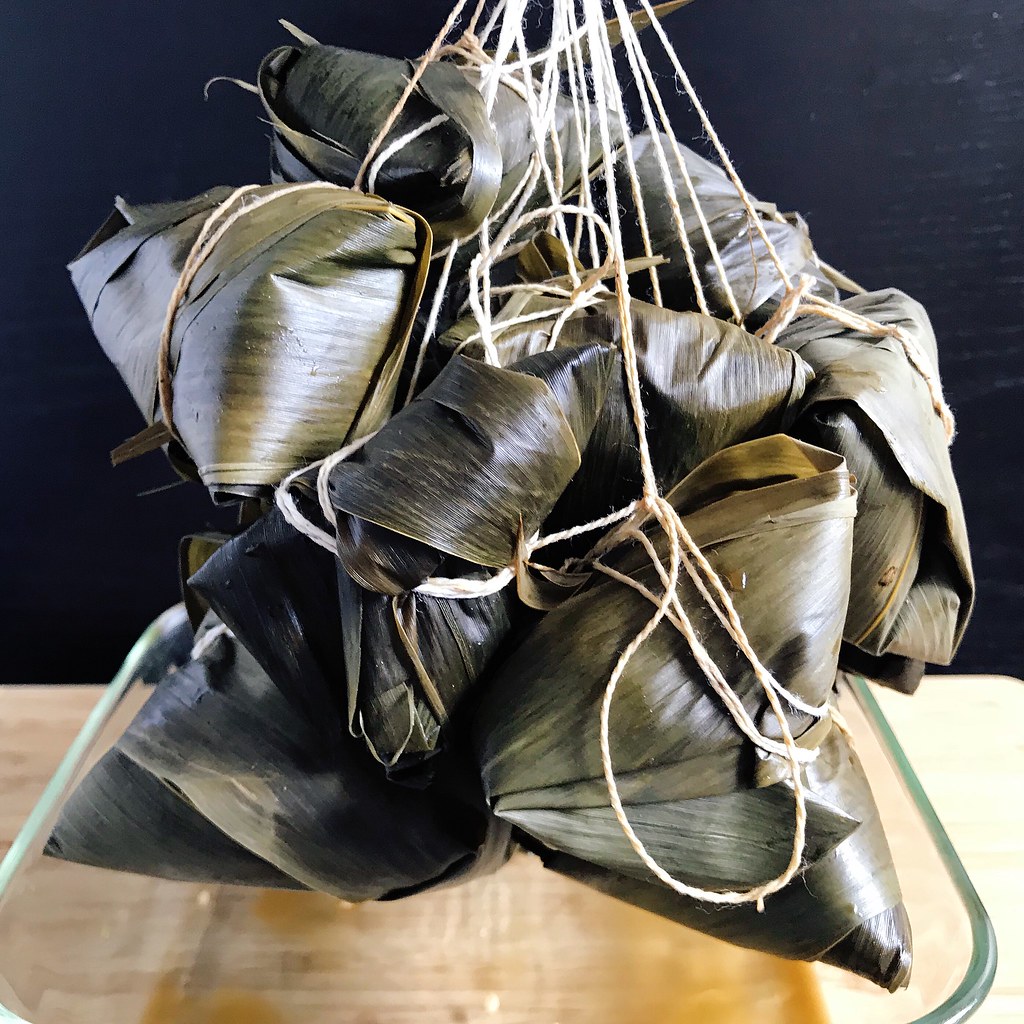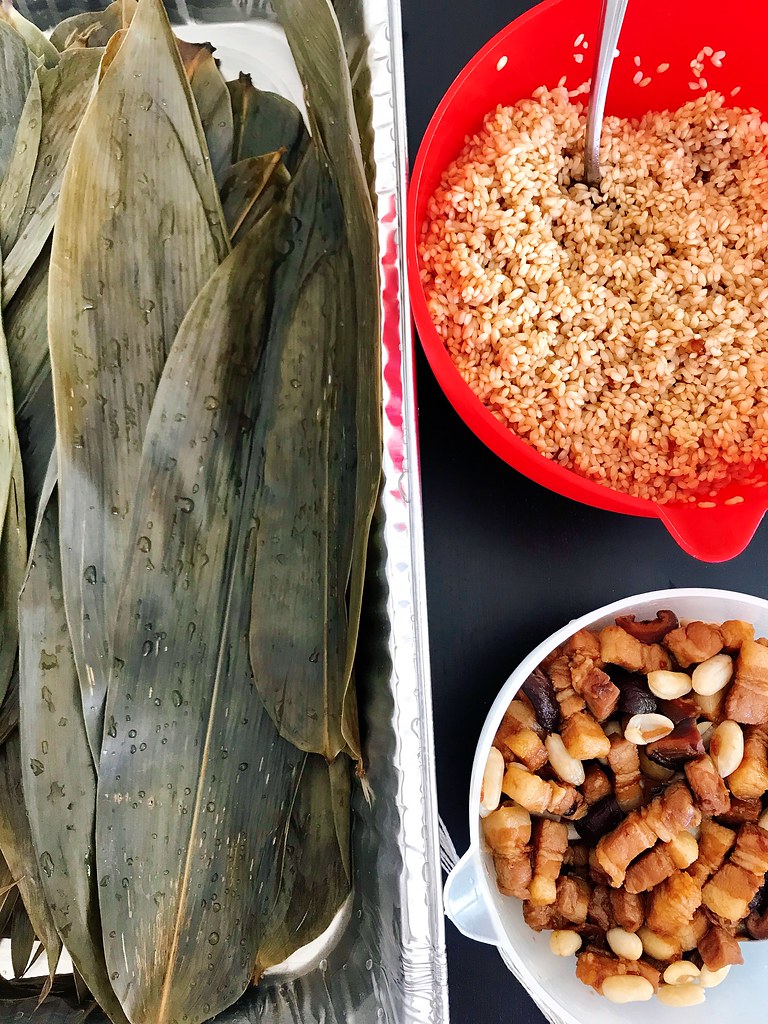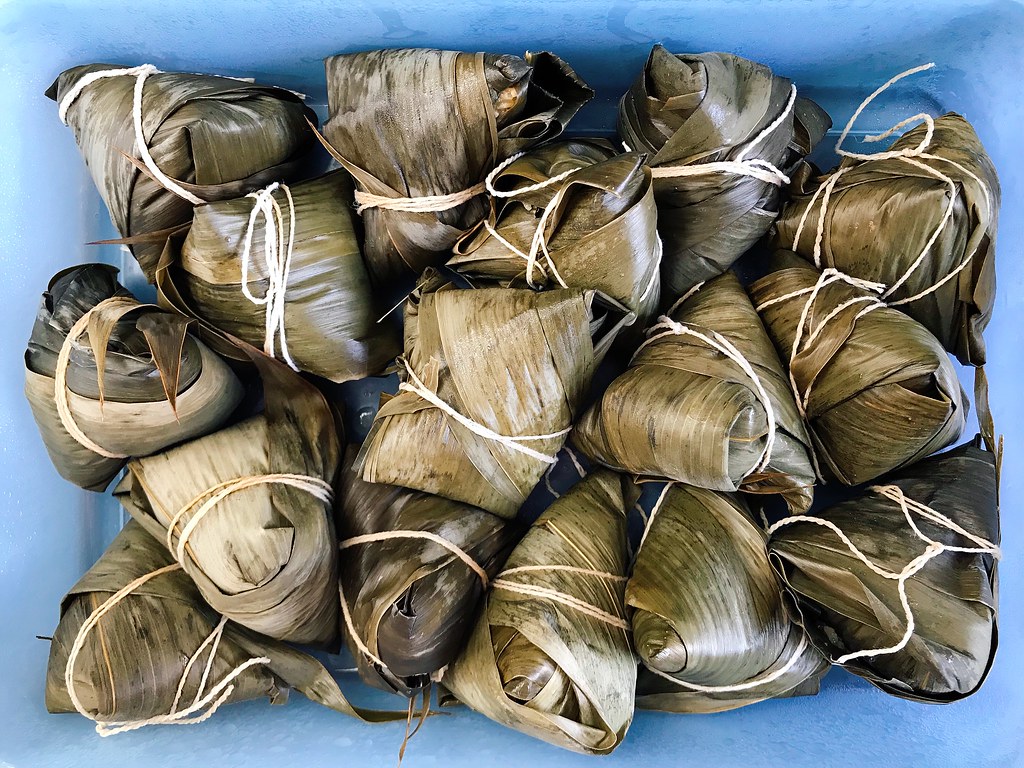I've been paddling in the annual Boston Dragon Boat Festival for over a decade now, and every year I consider trying to make zongzi, the traditional food eaten for the festival, but by the time the festival rolls around, I always find myself too busy with the races or traveling to attempt them. This year I decided to get a head start (the festival is celebrated on the 5th day of the 5th month of the lunar calendar, so June 18 this year). If you don't know what zongzi are, they're packets of sticky rice wrapped in bamboo leaves (or sometimes lotus or banana leaves). The fillings differ depending on where you are, and sometimes they're even sweet! The ones I grew up with were filled with marinated pork, shiitake mushrooms, fried shallots, peanuts, and sometimes chestnuts and/or dried baby shrimp. I've also had versions with salted duck egg yolks and Chinese sausage in them too.
Even beyond the fillings there are different ways to wrap zongzi. The ones my mom makes are shaped like tetrahedrons, whereas I've also seen them wrapped in a rectangular shape. Some of the recipes I've found online cook the zongzi in boiling water for up to 8 hours, but because the filling is cooked before being stuff in the sticky rice, you only need to cook these for an hour. My mom told me that in southern Taiwan they boil it for even shorter by wrapping cooked sticky rice and boiling just long enough to impart the bamboo leaf flavor.
I posted a picture of these zongzi on Instagram and mentioned that when I had asked my mom for the recipe, she told me it would be too hard to make. I don't think my mom has ever told me something would be too hard for me to do before, so it only made me want to make them even more. I was really surprised to read in the comments though that a lot of other people had the same reaction from their mothers when they had asked them for their recipe! I wonder if that's what their moms told them too, and they're just passing the advice along.
Since these are indeed very difficult to make, I wanted to share some of the tips I figured out while trying to figure it out myself:
- Soak at least 1.5 times as many leaves as you think you'll need. A good portion of mine would tear while I was trying to wrap them at which point you have to start all over. Don't throw those leaves away, though! Fold them in half vertically, and use wrap the outside of any of your more precariously wrapped zongzi to add another layer of protection.
- Be very careful handling the leaves. The edges are razor sharp and will give you a wicked paper cut!
- My mom folds the bottom of the leaves up so that the root ends don't stick out, but a lot of other people just cut that end off.
- My mom ties a bunch of strings to a doorknob so there's tension on the string when you try to tie it around the zongzi with one hand (the other hand is used to hold the zongzi tightly closed). Some of my friends mentioned that their moms would use a broomstick set across two chairs for the same purpose. I read somewhere that you can also hold one end of the string between your teeth, and actually that method worked the best for me, although I know my dentist friends would definitely frown on that because there's a chance of chipping your tooth from all the tension.
- I found that the easiest way to tie the string around the zongzi was to place it close to the anchored end and use your free hand to wrap the other end of the string multiple times around the zongzi. You want to try to wrap it around the "equator" of the tetrahedron, so that there are two corners on either end. This will help keep the string in place, otherwise it may fall off when you're cooking it (I know from experience).
I made this video to show you how to wrap the zongzi, but after showing it my mom to confirm it's how she wraps hers, she said she does it differently!
Then she sent me a link to this video which she said is more like how she wraps it. I love listening to it because you hear a mixture of Taiwanese and Mandarin which is kind of like what I heard growing up. That said, if you wrap it my way, you'll get smaller zongzi and will probably be able to make at least 24 with the amount of ingredients below. If you wrap it the way my mom does, you'll make fewer but, larger ones.
Taiwanese-Style Zongzi
makes 12-24 depending on how you wrap themTaiwanese-Style Zongzi
3 1/2 cups glutinous rice
6 oz. bamboo leaves
8 dried shiitake mushrooms
1/2 cup raw peanuts
2/3 cup soy sauce, divided
2 tablespoons rice wine
2 tablespoons sugar, divided
1 lb. pork belly
1 tablespoon oil
2 tablespoons fried shallots
Kitchen twine
Soak glutinous rice in room temperature water for 2 hours or overnight.
Soak bamboo leaves in room temperature water for an hour or overnight, weighing them down so they're completely submerged.
Soak shiitake mushrooms in room temperature water for an hour or overnight, also weighing them down so they're completely submerged. Soak the peanuts for an hour or overnight in a separate bowl.
Combine 1/3 cup soy sauce, the rice wine, and 1 tablespoon of sugar in a medium bowl. Slice the pork into bite-sized pieces and marinate in the soy mixture for an hour.
Cut the kitchen twine into 60" pieces (this is easy for me since that's my wingspan). Gather them all together and fold in half. Make a loop knot at that halfway point so that there are now twice as many pieces of 30" long twine connected at the top by a loop knot.
Wash the bamboo leaves thoroughly after they've softened. Drain the rice and then add the remaining soy sauce and sugar and mix. Cut the ends off the mushrooms and slice the caps into quarters. Drain the peanuts.
Heat a large wok or pan over medium heat and add the oil. Add the sliced mushroom, pork, and fried shallots. Stir fry until the pork is almost completely cooked through. Transfer to a bowl. Add any liquids left in the pan to the rice and mix well.
Set up your work station: hook the twine over a sturdy latch-style doorknob or cabinet handle*. Have the bamboo leaves, seasoned sticky rice, peanuts, and meat mixture nearby with a large spoon.
Grab two of the leaves and with the smooth sides facing you, position them so that they overlap slightly on the bottom and angle towards each other at the top. Fold the bottom half inch up and over so that the tough root end doesn't stick out anymore (or cut off the bottom half inch)*. Now fold the sides of the bottom of the leaves together like a book. Fold the bottom inch or two up along one side and then open up the leaves so that it forms a short cone.
Continue to grip the bottom of the cone with one hand and use the other hand to place a large spoonful or two of the rice in the cone. Pack it down well, then add a spoonful of the cooked filling, making sure to get a bit of each of the ingredients. Cover the filling with another spoonful of the rice and pack it down again. Fold the top of the leaves over the rice so that now you have a 4-sided pyramid. Fold the remaining portion of the leaves that are still sticking out together and then continue to wrap around the pyramid. Holding the pyramid tightly with one hand, use the other hand to wrap the twine around the middle a couple of times and then tie it off tightly. Leave it hanging from the twine and wrap the rest of the zongzi.
Bring a large pot of water to a boil and submerge the zong zi. Continue to cook for an hour, until the sticky rice is cooked through. Drain and let the zong zi cool before unwrapping to eat, discarding the leaf. Serve with sweet chili sauce and/or soy paste. These freeze very well, just microwave to reheat!
*See my tips above for variations.
Next: Strawberry Matcha Cream Cheese Tart
Previously: Candied Carrot Rose Tart
Last Year: Japanese Chicken Curry Rice
Two Years Ago: Tropical Pulled Pork on Griddled Banana Bread Sandwiches
Three Years Ago: A Better Homemade Pasta Recipe
Four Years Ago: Mushroom Marsala Pizza
Five Years Ago: Peking Duck Pizza
Eight Years Ago: Bacon Fat Caramels
Nine Years Ago: The Feng Family Secret Peking Duck
